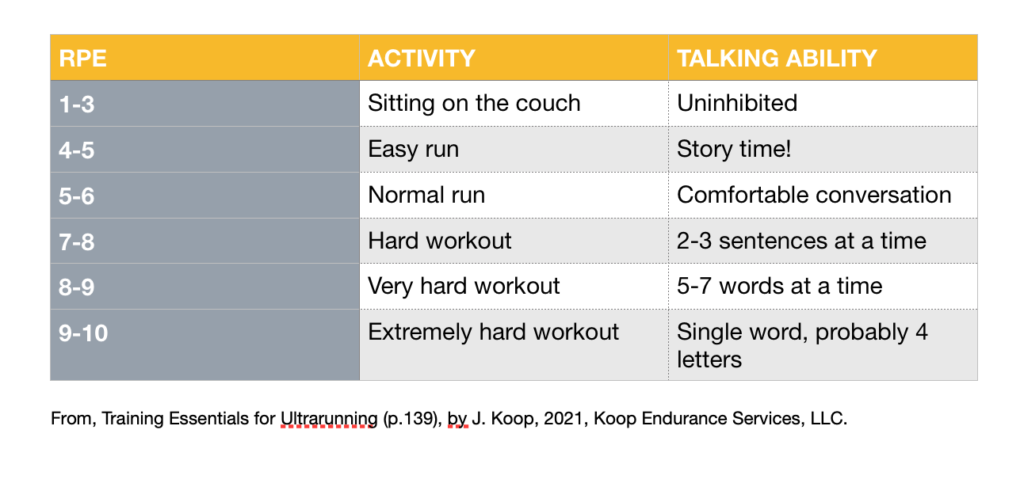Train Smarter, not Harder: How to Use RPE to Guide Training Intensity
With a thorough understanding of RPE (rate of perceived exertion), you will be able to train at the correct intensity at every workout, get the most out of each training session, and see results faster.
1. What is RPE?
RPE or rate of perceived exertion is a simple tool that can help you tune into your body in order to reach your fitness and running goals. The RPE scale is a subjective method to assess your physical exertion or pain level. Your RPE, rated on a scale of 1-10, is the measure of how physically and mentally difficult you feel an exercise or activity is. The RPE scale measures the intensity of your effort, with 1 being extremely light activity like a light stroll, and 10 being an all-out sprint that you can only maintain for a few seconds.
2. RPE Keeps You Honest
RPE gives us a universal language that can be used for measuring training or progress. Unlike your heart rate monitor or training by pace, RPE considers changes in terrain, weather, and tiredness. Running at a particular RPE should feel the same whether it’s cold or hot, whether you are running uphill or on the flats, whether you have had 10 hrs of sleep or a measly 6 hrs, whether you are running on an empty stomach or are well-fueled. Using RPE to guide your workout keeps you honest – you can run the hills without overtraining and the flats without slacking off.
3. RPE is Accurate
When done correctly, training by RPE can be more accurate than training by Heart Rate Zone (HRZ). HRZ training is another popular way to monitor training intensity. HRZ uses heart rate to define training zones based on an athlete’s heart rate at various exertion levels. HRZ training shares many of the advantages of RPE training but it has a couple of limitations.
HRZ training does not work well for new or de-conditioned athletes. De-conditioned athletes typically have a higher resting heart rate that tends to climb higher and faster than in conditioned athletes so heart rate tends to not correlate well with intensity. A de-conditioned runner, training by HRZ, may find that they are not training at the correct intensity based on heart rate alone. They will think they are following the training plan but actually, they are training at the wrong intensity and because of that, will not experience optimal results.
Another limitation of HRZ training is cardiac drift. All athletes experience their heart rate drifting higher than their predetermined HRZ tells them it should be when running in the heat or over long distances. Heart rate can also be affected by stress, sleep, caffeine, illness, and medication. RPE on the other hand connects training intensity to reality, so you can better follow your training plan.
4. RPE is Personal
Running based on RPE helps you take care of yourself. If you have had a particularly tiring day this may reflect in a slower pace during your workout. By running based on RPE instead of pace, you can maintain the same intensity in your training, but respect that your body is tired and accept a slower pace. Running based on RPE encourages you to listen to your body.
5. RPE is Unplugged
The best part about running by RPE is that it does not require any tech, gizmos, or gadgets. You do not need to buy anything, charge anything or plug anything in. You can run without constantly checking your GPS watch or adjusting your heart rate monitor. Just lace up your shoes and head out the door; which really is what running is all about in the first place.
Ultimately, when you train using RPE, you are more likely to train at the correct intensity level. Training at the correct intensity helps you get the most out of each workout session so you will see results faster. RPE will keep you on track with your training goals regardless of what life throws at you – heat, hills, or health – so you can be efficient with your precious training time and get to the starting line in top form.
Check out the RPE chart below. Spend a little time with it so you really understand what it means to train at each intensity level. Long runs and recovery runs should feel pretty easy on the RPE scale, tempo or threshold runs should feel moderate to hard, and sprints should feel very hard. Remember, however, this is a subjective scale, so interpretation is unique to each athlete.

Feel free to reach out if you have any questions. I’d love to hear how training by RPE works for you. You can reach me at [email protected]
